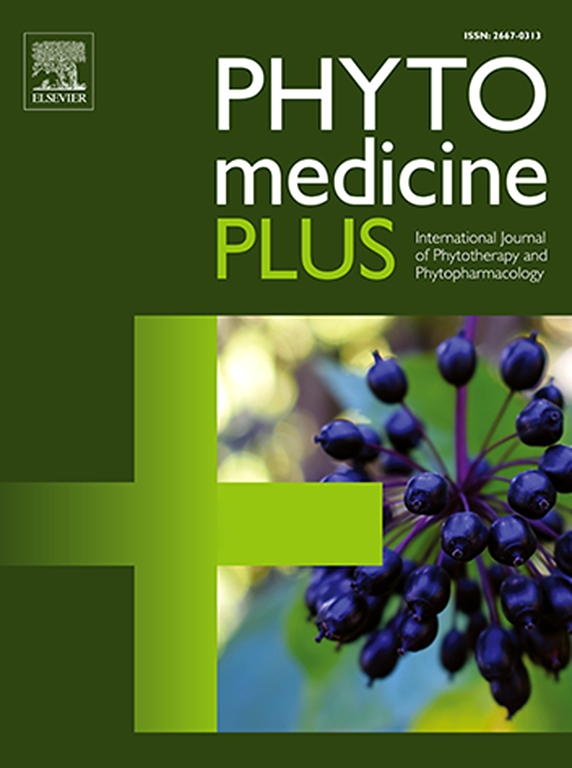Evaluation of the antidiabetic and antinephritic effects of Pueraria tuberosa and Pterocarpus santalinus extracts co-encapsulated in nanostructured lipid carriers in streptozotocin-induced mouse model
Q3 Pharmacology, Toxicology and Pharmaceutics
引用次数: 0
Abstract
Background
Diabetic nephropathy (DN) causes significant morbidity and mortality, leading to substantial psycho-economic costs. New strategies and medications are needed to manage DN more effectively.
Purpose
The antidiabetic and antinephritic properties of Pueraria tuberosa and Pterocarpus santalinus have been demonstrated in previous studies. However, poor oral bioavailability has limited their clinical application. A nanostructured lipid carrier (NLC) formulation was created and tested to address this problem. The promising experimental results suggest that this formulation holds potential for further clinical exploration.
Study design
The in vivo study evaluated the therapeutic potential of NLCs loaded with hydroalcoholic extracts of P. tuberosa tubers (PTE) and P. santalinus heartwood (PSE) in managing DN over eight weeks in streptozotocin (STZ)-induced diabetic mice.
Methods
The protective effects of PTE and PSE were evaluated in mice at a dose of 80 mg/kg body weight. Two weeks after STZ treatment, animals with blood sugar levels above 250 mg/dL were identified as diabetic and showed signs of nephritis. In these diabetic mice, PTE-NLC and PSE-NLC, individually and in their combined form (PTE+PSE)-NLC, were assessed for their hypoglycemic and nephroprotective effects. Animals were sacrificed for histopathological and biochemical analysis after eight weeks of therapy. Nanoparticles were characterized by their morphology, zeta potential, drug loading capacity, particle size, and release profile.
Results
In STZ-induced diabetic mice, treatment with (PTE+PSE)-NLC significantly improved pancreas and kidney health. It restored the kidney hypertrophy index, stabilized biochemical parameters, enhanced histopathological outcomes, and increased beta-cell count. Additionally, (PTE+PSE)-NLC led to a 30.53-fold more significant reduction in blood glucose levels than free (PTE+PSE) extracts.
Conclusion
Our findings highlight the potential of the NLC formulation of P. tuberosa and P. santalinus extracts in treating diabetic nephropathy. The bioactive compounds in these extracts play a crucial role in their antidiabetic and antinephritic effects, marking significant progress in the field.

在链脲佐菌素诱导的小鼠模型中,评价纳米结构脂质载体共包封的葛根和山紫檀提取物的降糖和抗肾作用
背景:糖尿病肾病(DN)引起显著的发病率和死亡率,导致大量的心理经济成本。需要新的策略和药物来更有效地管理DN。目的研究证实了葛根和蕨果的抗糖尿病和抗肾病作用。然而,口服生物利用度差限制了其临床应用。一种纳米结构脂质载体(NLC)配方被创建并测试来解决这个问题。实验结果表明,该配方具有进一步临床探索的潜力。研究设计:在体内研究中,研究人员评估了载有P. tuberosa tubers (PTE)和P. santalinus心材(PSE)水酒精提取物的NLCs对链脲佐菌素(STZ)诱导的糖尿病小鼠治疗DN的治疗潜力。方法以小鼠80 mg/kg体重为剂量,观察PTE和PSE的保护作用。STZ治疗两周后,血糖水平高于250 mg/dL的动物被确定为糖尿病,并表现出肾炎的迹象。在这些糖尿病小鼠中,分别评估PTE-NLC和PSE-NLC单独以及它们的组合形式(PTE+PSE)-NLC的降糖和肾保护作用。治疗8周后处死动物进行组织病理学和生化分析。纳米颗粒的形貌、zeta电位、载药量、颗粒大小和释放谱等均被表征。结果在stz诱导的糖尿病小鼠中,(PTE+PSE)-NLC治疗可显著改善胰腺和肾脏健康。它恢复了肾脏肥大指数,稳定了生化参数,增强了组织病理学结果,增加了β细胞计数。此外,与游离(PTE+PSE)提取物相比,(PTE+PSE)-NLC使血糖水平降低30.53倍。结论本研究结果表明,结核参、桑参提取物的NLC制剂具有治疗糖尿病肾病的潜力。这些提取物中的生物活性成分在其抗糖尿病和抗肾病作用中发挥了至关重要的作用,标志着该领域的重大进展。
本文章由计算机程序翻译,如有差异,请以英文原文为准。
求助全文
约1分钟内获得全文
求助全文
来源期刊

Phytomedicine Plus
Medicine-Complementary and Alternative Medicine
CiteScore
3.70
自引率
0.00%
发文量
178
审稿时长
81 days
期刊介绍:
 求助内容:
求助内容: 应助结果提醒方式:
应助结果提醒方式:


